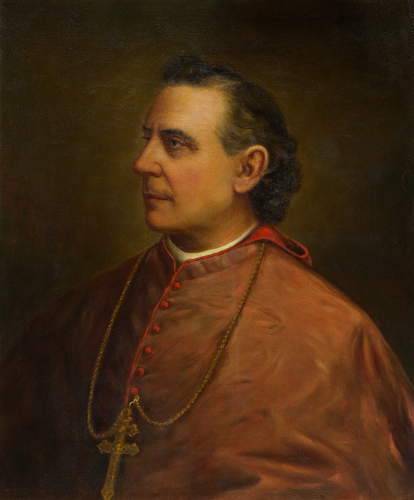May 20, 2013
Portrait of Chicago’s Archbishop Feehan presented to DePaul
Portrait of Chicago’s Archbishop Feehan presented to DePaul
CHICAGO – Although he was the second-longest-serving leader
of the Chicago archdiocese, presided over explosive growth in Chicago’s
Catholic community and laid the groundwork for many of Chicago’s most important
Catholic institutions, Archbishop Patrick Feehan remains far from a household
name in his adopted city.
But a long-forgotten portrait of the archbishop, recently
found in the basement of an academic building at All Hallows College in Dublin,
Ireland, has just been given a place of honor at DePaul University, one of the
institutions Feehan helped establish. It
will hang in the board room of Cortelyou Commons, 2324 N. Fremont St., Chicago.
Until now, only portraits of the presidents of DePaul have been displayed in
the building.
The Irish-born Feehan was Chicago’s archbishop from 1880 to
1902, and his tenure as head of the archdiocese was eclipsed only by that of Cardinal
George Mundelein, who served from 1915 to 1939. During the years of Feehan’s service,
Chicago’s Catholic population mushroomed from 230,000 to more than 800,000. Feehan’s
skills as an administrator and his sound management of financial matters won
him widespread admiration, according to his biography by the Rev. Martin
Zielinski in the Encyclopedia of American Catholic History.
Feehan also played a key role in founding major charitable
organizations such as the Mercy Home and Maryville, which both serve orphaned
children or those without stable family homes. He also was a national leader in
the development of Catholic education. One of his more visible contributions to
Chicago was the construction of the cardinal’s home at 1555 N. State Parkway.
Before coming to Chicago, Feehan served as bishop of
Nashville. He began his studies for the priesthood in Ireland and completed
them in St. Louis, where he studied with the Vincentian religious order. That
later inspired him to recruit the Vincentians to start what eventually would
become DePaul University, St. Vincent’s College which opened in 1898.
Though Feehan often shied away from public speaking, he created
a major impression on religious leaders around the world when he delivered the
welcoming remarks at the World’s Parliament of Religions, held during the
Columbian Exposition of 1893.
When he died suddenly of pneumonia at age 73, he was being
considered for appointment as the first cardinal of Chicago.
“In many ways, we consider Archbishop Feehan one of the founders
of DePaul. He encouraged the Vincentian community to open a college on
the north side of Chicago, and one year later in 1898, DePaul opened its
doors,” said the Rev. Dennis H. Holtschneider, C.M., president of DePaul, who
unveiled the newly restored portrait during the May 16 meeting of DePaul’s
Board of Trustees. “We are very proud to have this connection to
Archbishop Feehan and all of the wonderful things he did for the city of
Chicago.”
A photo gallery of the May 16 unveiling of the Archbishop
Feehan portrait by Holtschneider, is available on DePaul’s Facebook page at: http://depaulne.ws/FeehanPortraitphotos.
About DePaul
University
With approximately 25,000 students, DePaul is the largest
Catholic university in the United States and the largest private, nonprofit
university in the Midwest. The university offers approximately 275 graduate and
undergraduate programs of study on three Chicago and two suburban campuses.
Founded in 1898, DePaul remains committed to providing a quality education
through personal attention to students from a wide range of backgrounds. For
more information, visit www.depaul.edu.

A long-lost portrait of Chicago's first archbishop, Patrick Feehan, now hangs at DePaul University.
